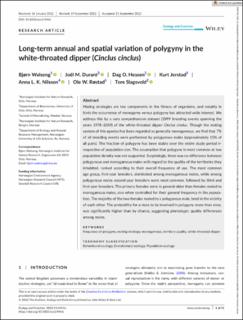| dc.contributor.author | Walseng, Bjørn | |
| dc.contributor.author | Durant, Joël | |
| dc.contributor.author | Hessen, Dag Olav | |
| dc.contributor.author | Jerstad, Kurt | |
| dc.contributor.author | Nilsson, Anna | |
| dc.contributor.author | Røstad, Ole Wiggo | |
| dc.contributor.author | Slagsvold, Tore | |
| dc.date.accessioned | 2023-03-30T11:58:36Z | |
| dc.date.available | 2023-03-30T11:58:36Z | |
| dc.date.created | 2022-10-24T15:47:31Z | |
| dc.date.issued | 2022 | |
| dc.identifier.citation | Ecology and Evolution. 2022, 12 (10), . | en_US |
| dc.identifier.issn | 2045-7758 | |
| dc.identifier.uri | https://hdl.handle.net/11250/3061161 | |
| dc.description.abstract | Mating strategies are key components in the fitness of organisms, and notably in birds the occurrence of monogamy versus polygyny has attracted wide interest. We address this by a very comprehensive dataset (2899 breeding events spanning the years 1978–2019) of the white-throated dipper Cinclus cinclus. Though the mating system of this species has been regarded as generally monogamous, we find that 7% of all breeding events were performed by polygynous males (approximately 15% of all pairs). The fraction of polygyny has been stable over the entire study period irrespective of population size. The assumption that polygyny is most common at low population density was not supported. Surprisingly, there was no difference between polygynous and monogamous males with regard to the quality of the territories they inhabited, ranked according to their overall frequency of use. The most common age group, first-year breeders, dominated among monogamous males, while among polygynous males second-year breeders were most common, followed by third and first-year breeders. The primary females were in general older than females mated to monogamous males, also when controlled for their general frequency in the population. The majority of the two females mated to a polygynous male, bred in the vicinity of each other. The probability for a male to be involved in polygyny more than once, was significantly higher than by chance, suggesting phenotypic quality differences among males. | |
| dc.language.iso | eng | en_US |
| dc.title | Long-term annual and spatial variation of polygyny in the white-throated dipper (Cinclus cinclus) | en_US |
| dc.title.alternative | Long-term annual and spatial variation of polygyny in the white-throated dipper (Cinclus cinclus) | en_US |
| dc.title.alternative | Long-term annual and spatial variation of polygyny in the white-throated dipper (<i>Cinclus cinclus</i>) | en_US |
| dc.type | Peer reviewed | en_US |
| dc.type | Journal article | en_US |
| dc.description.version | publishedVersion | |
| dc.description.version | publishedVersion | |
| dc.description.version | publishedVersion | |
| dc.subject.nsi | VDP::Zoologiske og botaniske fag: 480 | |
| dc.subject.nsi | VDP::Zoology and botany: 480 | |
| dc.source.pagenumber | 11 | en_US |
| dc.source.volume | 12 | en_US |
| dc.source.journal | Ecology and Evolution | en_US |
| dc.source.issue | 10 | en_US |
| dc.identifier.doi | 10.1002/ece3.9416 | |
| dc.identifier.cristin | 2064580 | |
| dc.relation.project | Norges forskningsråd: 221393 | |
| dc.relation.project | Andre: Swedish Research Council | |
| dc.relation.project | Andre: Norwegian Environment Agency | |
| cristin.ispublished | true | |
| cristin.fulltext | original | |
| cristin.fulltext | original | |
| cristin.fulltext | original | |
| cristin.qualitycode | 1 | |
